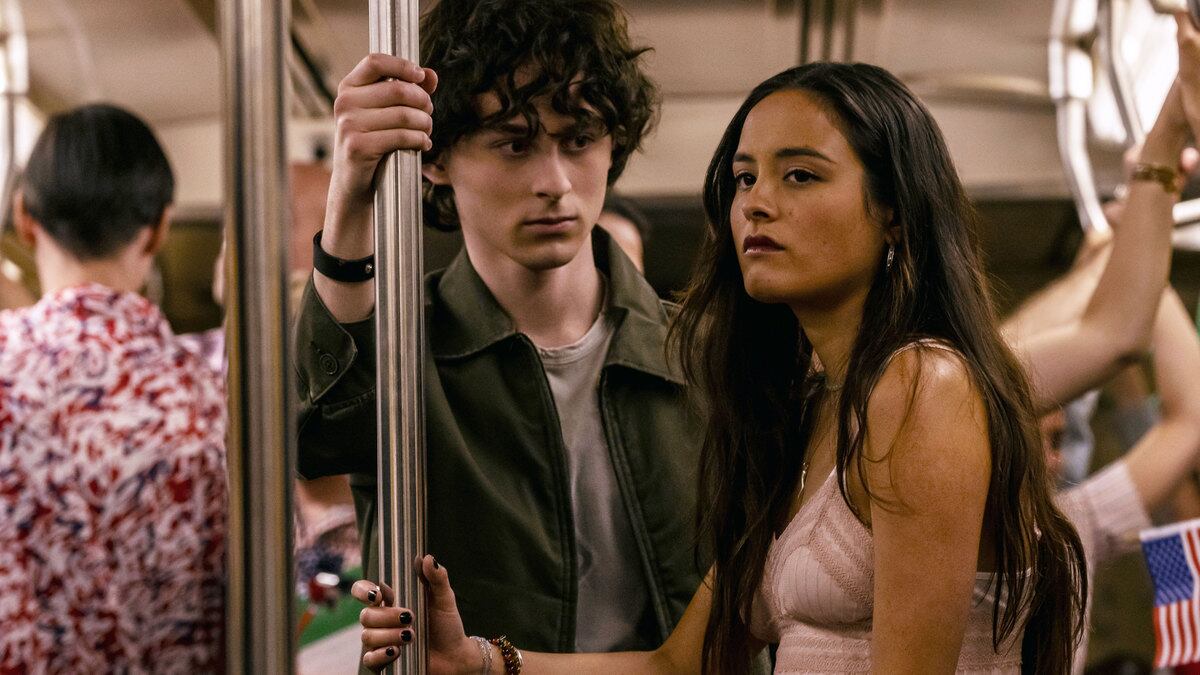Ah, how I’ve missed that sweet feeling, the sensation of traversing deeper into the pits of televised hell at every turn. If that was the intention—to grip viewers by way of increasingly absurd, nonsensical, and frustrating plot points—Apple TV+’s new drama City on Fire (premiering May 12) could actually be considered a raging success.
Created by the genius minds behind the original Gossip Girl, Josh Schwartz and Stephanie Savage, City on Fire certainly has enough going for it: a crack team of creators and writers with a proven track record for dishy teen dramas; an ensemble cast with recognizable faces like Chase Sui Wonders, Jemima Kirke, and Nico Tortorella; and even a pretty damn good pilot episode that nimbly sets the show up for a riveting mystery. But throughout its eight-episode first season, City on Fire is weighed down by its potential. The show unsuccessfully scrambles to keep its early promise from falling through its fingers, with a collection of truly unbelievable plot twists and hilariously hammy acting choices that pour gasoline all over an already raging flame.
City on Fire tracks the evolving puzzle that surrounds a seemingly random shooting in New York’s Central Park on July 4, 2003. There are no witnesses to the attack. But the victim, an NYU freshman named Sam (Wonders), is surprisingly well-connected, and the event soon lures everyone that was into her orbit into a complex web of secrets. Sam’s best friend, Charlie (Wyatt Oleff), grows desperate to find out the truth behind what happened to her. Naturally, this is in part because Charlie has been secretly pining over Sam, a feeling that will only cloud his better judgment when he learns what Sam had secretly been involved in.

Charlie was attracted to Sam’s free-spiritedness. She’s the archetypically enigmatic teenage girl that still spins vinyl (back when CDs were still a viable form of music consumption!) and religiously photographs bands at seedy nightclubs. Sam’s favorite band, Ex Nihilo, is a group of self-righteous crust punks, who choose to squat in squalor as a performative form of commitment to their art. And when the members of Ex Nihilo aren’t playing shows, they’re acting as amateur anarchists, bombing empty buildings—often at the behest of shady characters, whose money and influence run across the city like a subway map.
City on Fire spends a great deal of its first season examining the schism between these two worlds: the upper-crust New York elite, which Sam finds herself dallying with because of her lust for danger, and the down-and-out downtown gang with a penchant for arson. But once it comes time to merge these two parties, the show’s writers are incapable of coherently weaving a remotely believable arc. City on Fire rests its chances of success upon Charlie, hoping that he’ll emerge as a logical voice of reason, just by existing. But his character is terribly underwritten, as though the writers found out, halfway through the series, that they’re just as in over their heads as Charlie is, while trying to infiltrate an underground society of radicals.
A large part of this disconnect is likely due to the fact that this is an adaptation of a massive novel. Garth Risk Hallberg’s 2015 novel of the same name clocks in at a whopping 900-some pages, a fact that most of its reviews cited as a hindrance to its quality. Its source material’s exorbitant length might be why the writers of the adaptation often lob several ideas into the air, forgetting to look at where they might land by the time the first season closes. City on Fire reveals itself to be the ultimate example of throwing anything and everything at the wall, hoping it will stick. Few things ever do. Hell, the wall nearly collapses from the sheer weight of all of the nonsense hanging off of it.
That’s a substantial offense, considering all of the talents liable to find themselves in the series’ rubble. Wonders manages to do a respectable job at elevating City on Fire’s noxious revival of the manic pixie dream girl to something slightly more material. She may not imbue the character with much more depth than the script allows her, but she at least hooks the viewer with an unshakeable charisma, making for a believable point of obsession. Tortorella, who plays William—the original lead singer of Ex Nihilo, who has been increasingly tortured by drugs and destitution since he was kicked out of the band—brings a similarly grimy charm to this series as he did on seven seasons of Younger.
But then there’s poor Jemima Kirke, who seems to be on a different program altogether, both to her benefit and detriment. Kirke plays William’s sister, Regan, an exhausted Upper East Side mom whose marriage is falling apart. Regan is one of the few to hear gunshots ring out in Central Park, during her family’s swanky Fourth of July party. It doesn’t take long for her to become embroiled in Sam’s mystery, and for City on Fire to fixate on Regan—and depend on Kirke—to keep itself afloat in turn. But Kirke is treating City on Fire like it’s on par with Succession, or as if she shows up to the set, looks around, and loudly wonders, “Why is no one chewing on all of this scenery?”

But Kirke’s considerable talents aren’t enough to hold up a show already crumbling around her. As City on Fire goes on, it ramps up its post-9/11 paranoia, to embarrassingly clichéd effect. When characters aren’t crying “terrorism,” they’re spouting their distrust of government and institutions like it’s the new American religion. This could be a potent and relatable way to examine how little has changed over the last two decades—if the script dared to have any resolute messaging at all. City on Fire’s gang of nihilist, blaze-obsessed insurgents are all deeply insufferable, most notably their leader Nicky (Max Milner), whose most political act is sporting a mustache that wears him. (Contrary to popular belief, having bad facial hair is not the same as being marginalized.)
City on Fire does sometimes benefit from its outlandishness. Its increasingly obtuse plot points often ironically help the stretched runtimes feel shorter than they are, if only because you’ve been talking out loud to yourself, making fun of them for half of the episode. Like in Gossip Girl and The O.C., Schwartz and Savage are happy to toss plausibility out the window. At a certain point, you can’t help but throw your hands in the air and accept what’s happening. Bring on the terrible New York accents that veer on the vaudevillian; a scream-worthy, mid-episode animated sequence; or Sam’s father setting up an entire stereo system to play her favorite vinyl, in her hospital room, to try to lure her out of a coma.
If City on Fire got to that point of asininity a bit faster, it would be a much more rewarding and silly watch. Instead, it falls into the trap of aiming for prestige when it was always destined to be pure fluff. Let this be a lesson: There’s a very thin line between baked to perfection and charred to a crisp.






